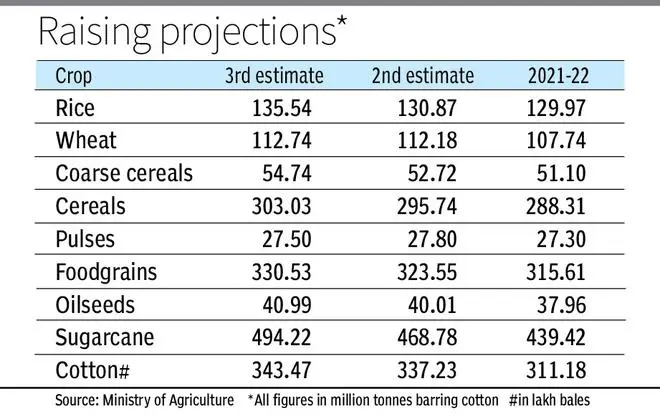Allaying fears over indifferent weather in February and March affecting rabi crops, the Indian government on Thursday raised its estimates for foodgrain production by another 2.1 per cent from the projections made in February.
In a new development, the Centre has come out with projections of the “Zaid” crop — sown between the rabi and kharif crops — separately unlike earlier years when they were treated as part of rabi crops.
In its third advance estimate of agricultural crops for the current crop year (July 2022-June 2023), the Ministry of Agriculture pegged foodgrains output at a record high of 330.53 million tonnes (mt). This is against 323.55 mt projected in the second advance estimate and 315.61 mt last crop year.
Contentious forecast
In what could turn out to be contentious in the following months, the Ministry projected wheat output at a new high of 112.74 mt (112.18 mt second advance estimate/107.74 mt last year).
The estimate comes amidst other agencies such as the Roller Flour Mills Federation of India pegging the production lower than 105 mt. Traders, too, say wheat production is lower, pointing to the procurement for the Central Pool stocks by the Food Corporation of India this year.
According to official sources, wheat procurement as of May 24 is 26.17 mt against a target of 34.51 mt.
Comfortable situation
With the Centre raising the kharif rice production by 2 mt to 110 mt (108mt/111 mt), overall output for the year has been pegged at a new peak of 135.54 mt with rabi projected at 15.89 and the “Zaid” crop at 9.61 mt.
The comfortable rice production this season is seen as one reason why the Government has permitted exports of fully broken rice, banned since September 8, 2022, under certain conditions such as meeting food emergencies of neighbouring and African countries.
The maize crop seems to have gained from the March rains with its production being raised to 35.91 mt (34.61 mt/33.73 mt). Overall, cereals production has been pegged higher at 303.03 mt (295.74 mr/288.31 mt).
Inflation concern
Coarse cereals production has been raised to 54.74 mt (52.72 mt/51.10 mt) with other gains forming from bajra and Shri Anna (nutri-cereals). Output of the rest such as jowar, small millets and barley is seen lower.
In what could be a concern for the Centre to control inflation, pulses production has been lowered to 27.5 mt (27.8 mt/27.30 mt). The output of tur has been cut to 3.43 mt (3.66 mt/4.22 mt) that of gram to 13.54 mt (13.62 mt/13.54 mt) and urad to 2.61 mt (2.68 mt/2.77 mt).
The production of nine oilseeds has been projected higher at 40.99 mt (40.01 mt/37.96 mt) with the output of rapeseed/mustard lowered to 12.49 mt (12.81 mt/11.96 mt). The production will still be a record high.
On the other hand, soyabean production has been pegged higher at 14.97 mt (13.97 mt/12.98 mt) which should cause concern for farmers in a market where edible oil prices are falling.
Catching the eye
Another estimate catching the eye is the increase in cotton production to 343.47 lakh bales from the earlier estimate of 337.23 lakh bales. This comes amidst confusion in the trade over the exact production of cotton.
While the Cotton Association of India lowered production estimate to lower than 300 lakh bales this month, cotton arrivals have zoomed to a nine-year high in May as farmers have begun releasing stocks they had held so far hoping to fetch higher prices.

Some traders are estimating the production between 340 lakh bales and 360 lakh bales.





Comments
Comments have to be in English, and in full sentences. They cannot be abusive or personal. Please abide by our community guidelines for posting your comments.
We have migrated to a new commenting platform. If you are already a registered user of TheHindu Businessline and logged in, you may continue to engage with our articles. If you do not have an account please register and login to post comments. Users can access their older comments by logging into their accounts on Vuukle.